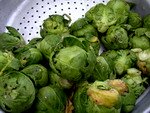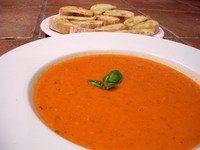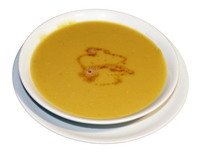There’s nothing tricky about thawing turkey. The only really important thing to remember is that it can take a pretty long time to thaw turkey. So the real key to knowing how to thaw a turkey is planning on having that time!
But what if you’re running low on time? Not to worry, there are different ways of thawing turkey, and some are quicker than others. So let’s find out how to thaw a turkey.
In this article, I’ll go over what happens when you thaw turkey — why all the fuss? Then, I’ll talk about the three different ways to thaw turkey: in the refrigerator, in cold water, or in the microwave.
Here we go!
What Happens When You Thaw Turkey?
It may seem like there’s a lot of fuss when it comes to learning how to thaw a turkey. But there’s a really good reason to follow one of the three methods in this article.
And what happens when you thaw turkey is that reason.
So here’s the story. There’s bacteria in turkey, like in any poultry. That’s perfectly normal, and nothing to worry about. When you cook your turkey,you kill all that bacteria — that’s why you need to heat the meat to just the right temperature.
When a turkey is frozen, so is the bacteria. That means it won’t grow at all. But when you thaw turkey, you’re giving that bacteria a chance to grow! And if it grows too much, even cooking it won’t kill enough bacteria to make the meat safe.
The good news? The bacteria will only really grow if the temperature gets above 40F (4C). So if you control the temperature just right, you can have a perfectly safe thawed turkey.
Special Tips
- Never thaw turkey at room temperature. The outside of the turkey will thaw before the inside, and it’ll get warmer than 40F, giving the bacteria an opportunity to grow. That could mean food poisoning!
- Never thaw a pre-stuffed turkey. The stuffing will be in contact with the raw turkey and get contaminated. But when you cook a turkey, the stuffing doesn’t get hot enough to kill the bacteria as efficiently.
- Thawing turkey can take a while. You can speed the whole process up a little bit by removing the giblet bag as soon as the turkey is thawed enough. Think of it as removing an ice pack from the inside of your turkey!
- To be safe, you should always carefully wash any surface that come into contact with raw turkey, and wash your hands thoroughly when you handle the turkey.
- What if you forgot to thaw your turkey and you just don’t have time? Don’t panic. You can actually cook the turkey while it’s still frozen. It just takes a little while longer.
How To Thaw A Turkey:
In The Refrigerator
The absolute best and safest way to thaw turkey is to thaw it in the refrigerator. Unfortunately, it’s the method that takes the longest time!
| But it really is the safest way, and it’s completely effort-free. The fridge is a perfectly controlled environment. You can set it to be at exactly 40F (4C), and so you know there won’t be any bacteria growth while your turkey thaws. |
 |
Here’s how you do it:
- Keep the turkey in its original wrapping. Ideally, it’s perfectly sealed so that you won’t get any turkey drippings contaminating your fridge.
- Place the turkey on a tray, so that if the packaging does leak, it stays in the tray.
- Place the turkey on the lowest shelf in the fridge. This way, if an accident happens, it won’t contaminate all your shelves.
- Thawing turkey in the fridge takes about 5 hours per pound. This adds up really quickly:
| Turkey Weight | Thaw Time In Refrigerator |
| 10 to 14 lbs | 2 to 3 days |
| 14 to 18 lbs | 3 to 4 days |
| 18 to 22 lbs | 4 to 5 days |
| 22 to 26 lbs | 5 to 6 days |
Thawing turkey in the fridge really does take a long time, and takes up quite a bit of room, too. So why is it the best method?
- As I mentioned, it’s the safest. The perfectly controlled environment means you’re not giving the bacteria a chance to grow.
- Once the turkey is in the fridge, you can forget about it. You don’t have to put in any more effort or time until it’s time to cook the turkey.
- Because it’s such a safe way to thaw the turkey, you can leave the turkey in the fridge for a day or two before cooking it once it’s fully defrosted. So you can even thaw the turkey a bit ahead of time, if it’ll ease your worries.
And that’s how to thaw a turkey in the refrigerator!
How To Thaw A Turkey:
In Cold Water
If you don’t have the time or the fridge space to thaw turkey in the refrigerator, don’t worry. We’re about to talk about how to thaw a turkey in cold water.
Thawing turkey in cold water is much, much faster than thawing it in the fridge, but it’s a lot more effort if you want to keep it safe.
 |
Why? Remember, bacteria starts to grow at 40F. So you have to keep your water very cold, which means changing it regularly, as soon as it warms up. |
Here’s how you do it:
- Keep your turkey in its original wrapping, or in a leak-proof plastic bag.
- It’s really important that there be no leaks, so that you avoid cross-contamination.
- You also don’t want water to seep in to your turkey and make it watery.
- Completely submerge the turkey in ice-cold water. The water should be as close as possible to 40F.
- You can use the sink or a basin to thaw the turkey. A sink is handy because it makes changing the water a breeze.
- A cooler is an even better choice. It’ll keep the water from warming up as fast, so that you don’t need to change it as often. And if you only have one sink, you probably don’t want a turkey taking it up for 10 hours!
- Keep an eye on the water temperature. You can keep it cool with ice packs, but if the water gets to be about 50F or much warmer than your coldest tap water, you need to change it.
- Thawing turkey in cold water takes about 30 to 45 minutes per pound.
- Even if your water is at 40F, just like your fridge, water transfers heat much more easily than air. That’s why it’s so much faster.
- On the same note, if your turkey packaging is very tight, it’ll take less time to defrost than a turkey in packaging with an insulating layer of air.
Turkey Weight Thaw Time In Cold Water 10 to 14 lbs 5 to 10 hours 14 to 18 lbs 7 to 14 hours 18 to 22 lbs 9 to 17 hours 22 to 26 lbs 11 to 20 hours - Once the turkey is thawed, you should cook it as soon as possible.
- It’s not as controlled an environment as the refrigerator, so there may have been some bacteria growth.
- Because of that, it’s not always safe to leave a turkey in the fridge after you’ve thawed it in cold water.
Thawing turkey in cold water is much, much faster than thawing it in the refrigerator, but there are a few things you need to keep in mind.
- It’s a lot more work than thawing it in the fridge, because you have to change the water.
- Larger birds take long enough to thaw that they’ll need to thaw overnight. And because you should cook the turkey soon after it’s thawed, you may even need to thaw smaller birds overnight.
How To Thaw A Turkey:
In The Microwave
| We’ve seen how to thaw a turkey in the refrigerator and in cold water. But what if you’re really, really out of time? Then it’s time to talk about how to thaw a turkey in the microwave. |
 |
The first thing I want to say is that thawing turkey in the microwave isn’t the best way to go. It’s okay if you’re stuck, but if you have time, avoid it!
- The microwave heats unevenly. It heats the meat differently depending on whether it’s touching the bone or not. That means that some parts of the turkey will actually start to cook before others are thawed. That can mean tougher meat.
- Depending on how big your microwave is, you might not be able to fit the turkey in there. It really only works for smaller birds, or turkey parts.
But, if you’re really in a jam and need to know how, here’s how to thaw a turkey in the microwave.
But, if you’re really in a jam and need to know how, here’s how to thaw a turkey in the microwave.
- Remove all the packaging, wrappings, and anything that might not be microwave safe.
- Place the turkey on a microwave safe tray or platter, to catch any drippings.
- Unfortunately, since all microwaves are different, you’ll have to read your microwave’s manufacturer’s instructions to know how long to defrost the turkey.
- Depending on how big it is, thawing a turkey in the microwave can take an hour or even two.
- When you can, remove the giblet bag. It’s fine when it’s frozen, but some giblet bags aren’t microwave safe and need to be taken out as soon as possible.
- Once the turkey is thawed, you have to cook it right away. Some parts of the turkey will have started to be warm and cook, and they’ll be at the perfect temperature for bacteria to grow. Cooking the turkey is the only way to stop them from growing too much.
And that’s how to thaw a turkey! It’s the first step towards a delicious turkey dinner.



















